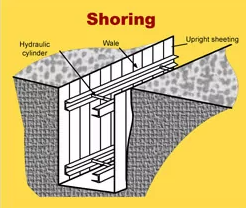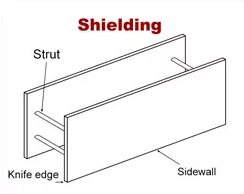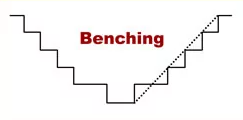
We define excavation as “the process of removing earth, rock, or other materials from a given area, commonly to create a foundation or structure.” It’s the first step in many construction projects.
It is a key component of many industries, including construction, restoration, mining, landscaping, and more. Skilled workers, ranging from laborers to heavy machinery operators, prepare the earth for concrete and other crews to come in after and build.
It’s groundbreaking.
In this guide, we will answer all your excavation questions –from the basics of what an excavator is to the more complex topic of shoring in excavation. So, let’s start digging deeper!
What is an Excavator?

An excavator is a heavy-duty machine used to dig, scoop, and move large amounts of soil, rocks, and debris. It consists of a boom, bucket, and cab mounted on a rotating platform with tracks underneath.
The operator sits in the cab and controls the excavator’s movements using levers and pedals.
Excavators come in different sizes and types, depending on the project’s requirements.
Mini excavators, for instance, are compact and versatile and are ideal for small-scale jobs such as backyard landscaping. In addition, their tracks are rubber and won’t tear up the ground below them as much as steel.
On the other hand, mid to large excavators are used in major construction projects like building bridges and highways. The Liebherr R9800 is reported to have the heaviest operating weight weighing in at 800 tons!
⇒Tip: Excavation companies can use tires to track an excavator over pavement and concrete. You need around 8 medium to large tires. When you are ready to track the excavator across, line the tires up with the tracks, leaving about 1 ft of space between them. As the excavator reaches the last set of tires with the front of its tracks, grab the tires from behind and place them back in front! This handy trick prevents you from paying fines for road and structure damages.
Top Excavator Companies
There are multiple articles that compare Construction Equipment. They rank different machines based on their weight, between 10 and 20 tons! Each brand distinguishes itself from the other, but what excavation companies look for often depends on the machine’s operating pattern (We will get into that in a minute).
Here are some of the most common brands in the united states:
- Caterpillar
- John Deere
- Link-Belt
- Komatsu
- Kubota
- Bobcat
- Volvo
- Sany
- Hyundai
- Hitachi
- Case
- Doosan
Did you know operating one excavator can be completely backward than a different one? Even the most skilled equipment operators rarely (if ever, I have met 1 guy out of thousands!) can switch seamlessly between the two! After you learn one pattern, running a machine on the other is extremely difficult.
Trying to validate which operating pattern is the “best” is like the iPhone VS Android debate. Some users say they will never switch, and some don’t! That is how it is in the excavation world. Brands like Link-Belt, Bobcat, and Kubota can operate on either. A switch or lever is commonly found next to or under the seat of a mini excavator, and by the battery on larger machines.
SAE (CAT) VS ISO (John Deere) Operating Pattern
SAE and ISO controls are the primary operating systems for excavators. SAE controls are also known as Standard or CAT controls, with the left joystick responsible for your swing left, swing right, boom up when pushed forward, and boom down when pulled back. The right joystick is responsible for the bucket’s ability to curl in and out, and the stick moves away when pushed forward and is brought closer when pulled back.
ISO or John Deere left joystick still is responsible for the machine’s left and right swing, but when pushed forward moves the boom down and, when pulled, brings the main boom down. Leaving the right joystick with curling the bucket in and out, and when pushed forward, the stick moves away; when pulled towards you, the stick is close.
Check out this video by Heavy Metal Learning that goes into the specifics behind Excavator Control Patterns –
Importance of Trenching in Excavation
OSHA reported 35 deaths caused by trench walls collapsing in 2022. Shoring, shielding, benching, or sloping are different options for keeping your crew safe. Before digging, call to locate underground utilities by dialing 811. Have and implement a proper trenching technique to keep all employees safe.
What is Shoring in Excavation?

Shoring is the process of supporting a trench or excavation site’s walls to prevent collapse or cave-ins. It involves installing temporary structures such as steel or plywood along the walls with support beams (perpendicular to the wall) applying pressure.
Shoring is crucial in excavation because it ensures the safety of workers and the surrounding area. The trench walls can collapse without proper shoring, leading to injuries, fatalities, or property damage.
What is Shielding?

Shielding is when you see companies using trench boxes. These fit into the trench and prevent the sides from collapsing on employees.
Shielding is beneficial for laying water and sewer lines. These underground lines are typically deeper than gas and utilities. Therefore, trench boxes are moved quickly when main water and sewer lines are installed. This allows for the backfilling process to start before the pipes are laid.
What is Benching?

Benching is a trenching technique used to create a series of steps or benches in the excavation’s walls. It involves cutting the soil at an angle, creating a series of terraces that prevent the walls from collapsing.
Benching is commonly used in deep excavations where shoring alone may not be sufficient to support the walls. It is an effective way to ensure worker safety and minimize the risk of soil collapse.
What is Sloping?

A trenching technique that allows the operator to cut the trench wall at an angle to create a slope, a method that is similar to benching in that they don’t require extra materials to prevent cave-ins.
4 Top Resources for Excavation Companies
There are tons of great resources for everyone involved in the excavation process- laborers, operators, supervisors, contractors, you name it. Here are 4 of our favorites to check out:
Excavation Calculator and an Excavation Cost Calculator: Free Online Excavation Calculator
- Quickly estimate the volume and cost of excavated materials at the touch of a button!
Construction Time Tracking Software: Excavation Timesheet | Mobile Excavation Time Clock
- A user-friendly app that accurately tracks employee time. With over 1,700 5-star reviews, you should see which plan fits your business right now.

Employee Timesheets: Printable Timesheet Template | Free Timesheet Template
- Choose a timesheet template, bi-weekly, monthly, semi-monthly, and weekly. Download and customize, or simply print off and fill in by hand. *Not recommended for growing or medium to large businesses.

Keeping up with current technologies: The 27 Best Construction Trade Shows and Expos in 2023
- This article covers the top construction trade shows and expos companies can attend to learn about the latest industry trends.
Conclusion
Excavation is an essential part of many construction, mining, and landscaping projects, and it requires skilled workers, specialized equipment, and careful planning and execution. Whether you’re a contractor, project manager, or homeowner, we hope you found some value in this article!













One comment on “What is Excavation?”
Comments are closed.